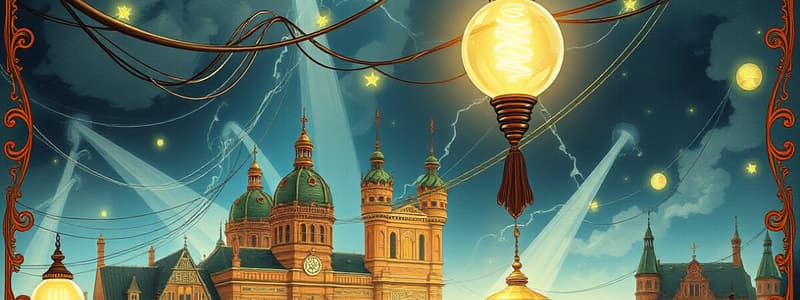Podcast
Questions and Answers
Who tied a key to a kite string during a thunderstorm?
Who tied a key to a kite string during a thunderstorm?
Benjamin Franklin
What did Alessandro Volta create in 1800?
What did Alessandro Volta create in 1800?
The first electric cell
What principles are electric generators and motors based on?
What principles are electric generators and motors based on?
Passing a magnet through a copper wire
In what year did Thomas Edison start the Pearl Street Power Station?
In what year did Thomas Edison start the Pearl Street Power Station?
Electricity is a primary energy source.
Electricity is a primary energy source.
What is the flow of electrical power or charge known as?
What is the flow of electrical power or charge known as?
Who discovered the rotating magnetic field?
Who discovered the rotating magnetic field?
What could be transported further, AC or DC power?
What could be transported further, AC or DC power?
Which of these was Edison known for?
Which of these was Edison known for?
What was Nikola Tesla's main contribution to electrical systems?
What was Nikola Tesla's main contribution to electrical systems?
Flashcards are hidden until you start studying
Study Notes
Brief History of Electricity
- Goal was to find a cheap and safe lighting solution for homes.
- Benjamin Franklin's kite experiment (1752) established a link between static electricity and lightning.
- Alessandro Volta developed the first electric cell in 1800 using a chemical reaction of zinc and copper with saltwater, leading to the creation of the battery, known as the Voltaic Pile.
Key Contributions to Electricity Generation
- Michael Faraday discovered that moving a magnet through a copper wire generates electric current. This principle underlies both electric generators and motors, facilitating energy conversion from motion to electricity and vice versa.
- Thomas Edison invented a practical light bulb in 1879 and built the first electric power plant, the Pearl Street Power Station, in New York City (1882). This provided electricity to 85 customers, powering 5,000 lamps.
- Initial electricity cost equated to $5.00 per kilowatt-hour, while current prices are significantly lower: approximately 13 cents for residential, 10.7 cents for commercial, and 6.8 cents for industrial customers.
Transition to Alternating Current (AC)
- Nikola Tesla introduced the concept of alternating current after his collaboration with Edison ended. He developed the rotating magnetic field and formed a partnership with George Westinghouse to create the AC system.
- AC technology enabled long-distance electricity transmission, outperforming Edison's direct current (DC) system, which had a limited transmission range of one square mile.
- Tesla's innovations included the Tesla Coil, essential in modern science and radio technology, and the electricity generation system for the Niagara Falls power plant, capable of delivering power over 200 miles.
Understanding Electricity
- Electricity is classified as a secondary energy source, created by converting primary energy forms such as coal, natural gas, nuclear, solar, and wind energy into electricity.
- It is considered an energy carrier, allowing for conversion into other energy forms like mechanical energy or heat.
- Electricity itself is not renewable or nonrenewable; it facilitates energy flow and is essential in various applications, making it a fundamental part of modern life.
Studying That Suits You
Use AI to generate personalized quizzes and flashcards to suit your learning preferences.




